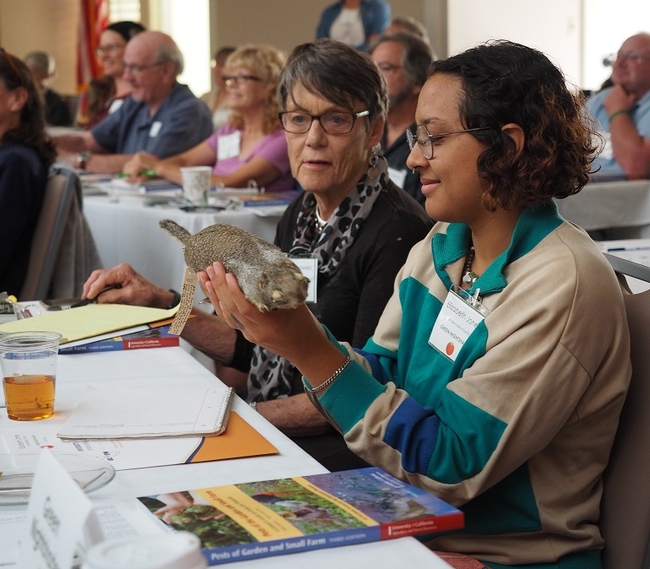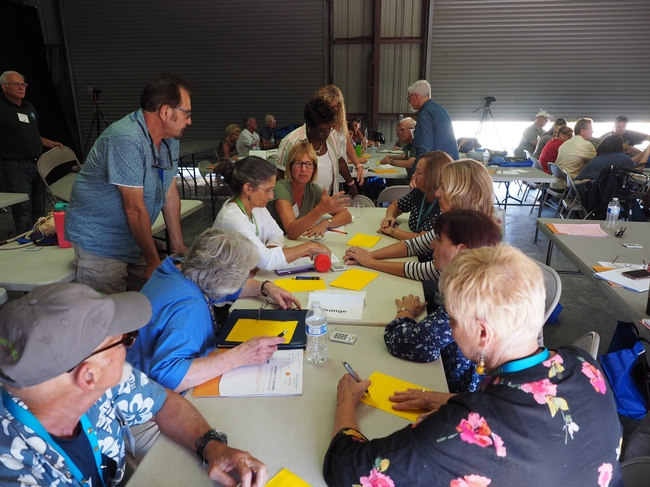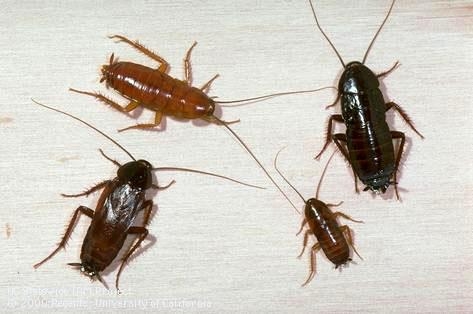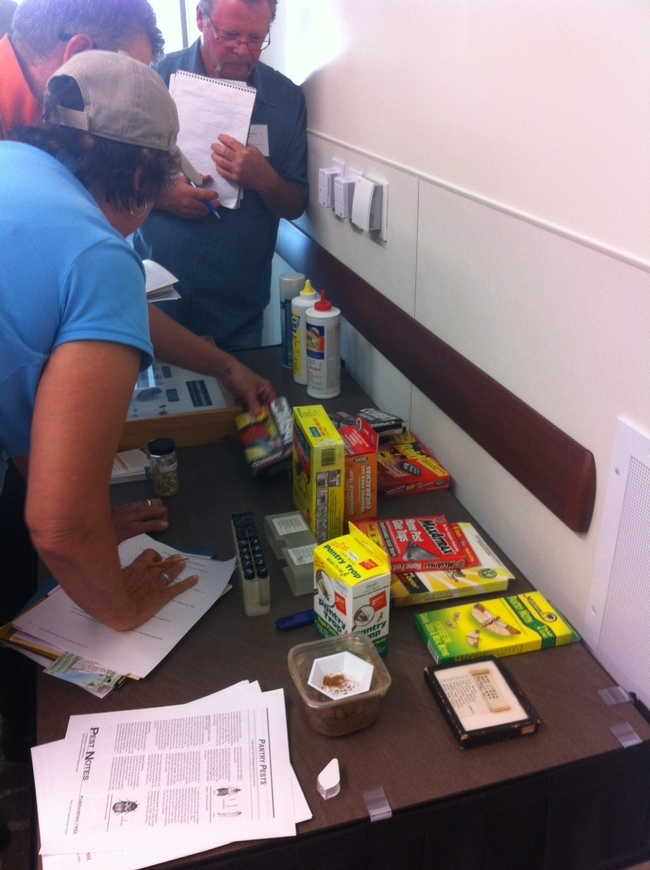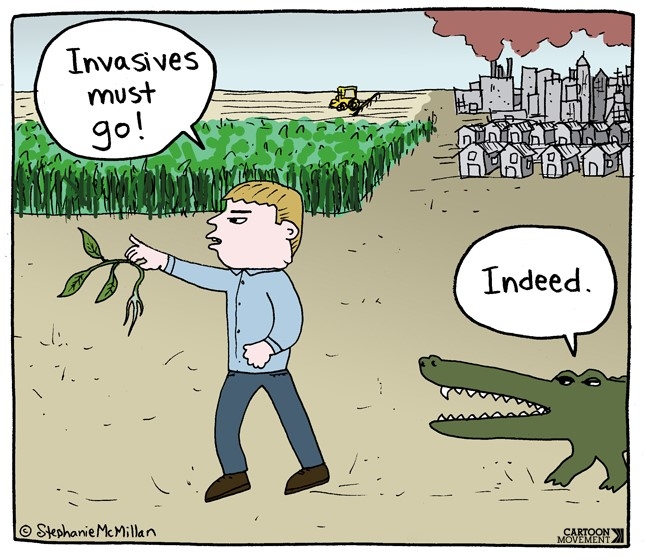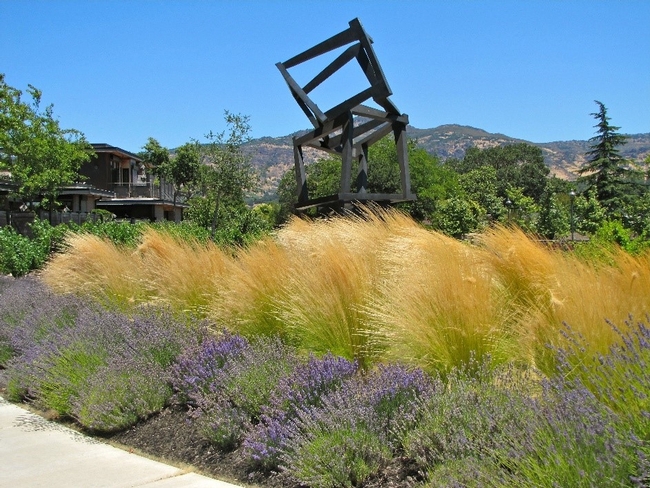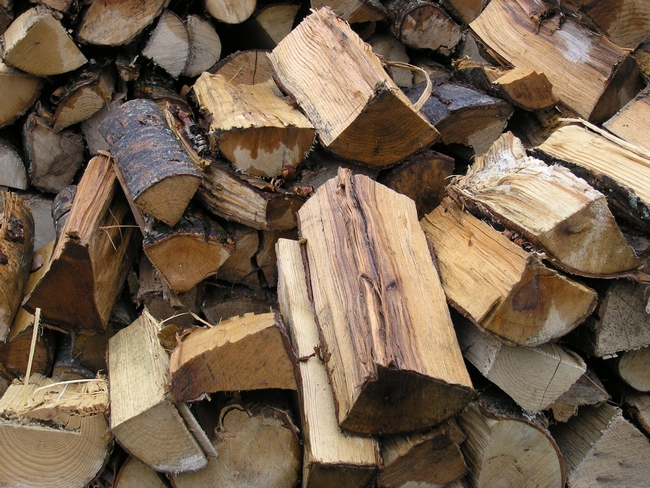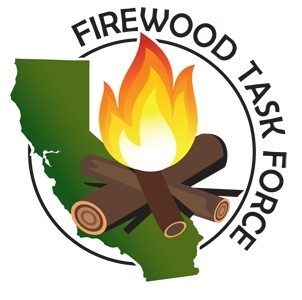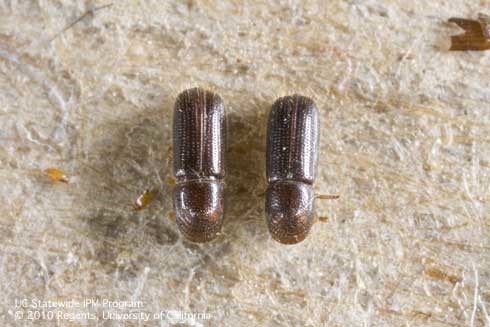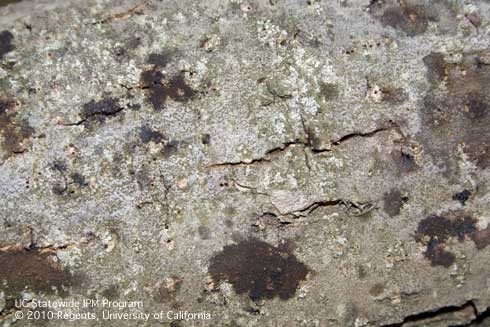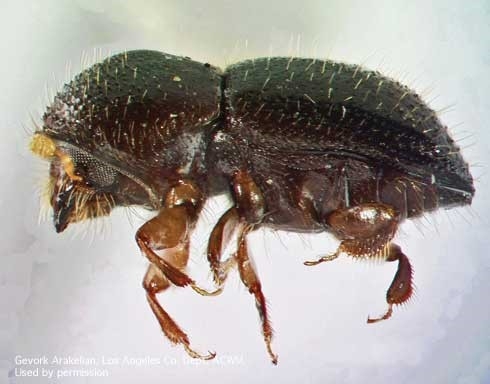Posts Tagged: Pests
Vegetable Pest Management Training Series a Success
It may seem odd to see seventy-five people at a hotel conference center learning about insects and rats on vegetables, but not if you are a UC Master Gardener. The UC Statewide Integrated Pest Management Program (UC IPM) in partnership with the UC Master Gardener Program just wrapped up the Vegetable Pests and Solutions train-the-trainer series. More than 340 UC Master Gardener volunteers from across the state took part in the regional trainings offered in Fresno, Orange, Placer, San Luis Obispo and Sonoma counties.
Active Learning
The advanced UC IPM training offered a hands-on, train-the-trainer experience that increased participants' knowledge of insect pests of vegetables, vegetable plant diseases and disorders, and vertebrate pests of gardens and homes. One of the highlights of the training was Human-Wildlife Interaction Advisor, Niamh Quinn, showing a taxidermy collection of vertebrate pests at the Orange and San Luis Obispo County workshops. Being able to handle and observe the different markings, colors and claws on certain animals makes future identification easier as participants learned the signs to look for when identifying vertebrate pest damage in the vegetable garden.
UC Master Gardener volunteers were lead through exercises that mimic questions commonly received from the public. Some of the questions had a photo, others just a sparse description that volunteers worked together to solve using online IPM resources and materials provided at the training. The exercises were designed to challenge and expose the learner to different types of scenarios and tools they can use in the future.
Outreach and Education
The UC Master Gardener Program's mission is to extend research-based information, by attending advanced trainings such as this, volunteers are even more prepared to contribute to the program's mission. With exposure and practice using new resources and materials training attendees have the tools and knowledge needed to educate the public on vegetable pests and solutions including scripted PowerPoints, activities, handouts, and vegetable pest identification card sets. One attendee reported “As a first year UC Master Gardener, this training helped me become more comfortable and more confident researching answers for pest management questions.”
At the conclusion of the training volunteers convened with their fellow county volunteers to talk about their plans to take new found knowledge back into their communities. Some of the great ideas generated were:
- offer seasonal pest problems workshops
- include a “Need Help Solving Pest Problems?” flier for all events
- add IPM tips to newsletters and social media
- integrate IPM into presentations as appropriate or relevant to topic
- add signage for damaged or diseased plants with IPM solutions in demonstration gardens
- share IPM toolkit at farmers markets and demo garden events
How We are Making a Difference
One portion of the agenda was focused on how the UC Master Gardener community is making a difference. With 6,000+ volunteers serving more than 517,000 Californians per year the impact of the UC Master Gardener volunteer effort is truly amazing. Through statewide program evaluation efforts the impact in sustainable landscaping, food gardening and community well-being is now being analyzed and reported in the programs annual report. Volunteers can see the impact they are having statewide and be proud of being part of a group that social changes they are seeing in their local communities.
As active volunteers and life-long learners UC Master Gardeners are a powerful educational tool and inspiration for others not only in the garden but in the volunteer community. Statewide educational offerings like UC IPM's train-the-trainer series help hone the diagnostics skills while building confidence in the subject matter.
The next statewide training opportunity for UC Master Gardener volunteers will be the 2020 UC Master Gardener Conference, Sept. 28 –Oct. 2, 2020 at the Granlibakken, Tahoe. The conference is the beginning planning stages and taking speaker and topic suggestions, click here to suggest a speaker or topic.
UC Master Gardener volunteers know household pests!
It's well known that the UC Master Gardener Program produces dedicated volunteers who are extremely knowledgeable about home horticulture and gardening. UC Master Gardener volunteers; especially those working at help desks, hotlines, and farmers markets, respond to thousands of requests each year, extending information and resources to California's residents that help them maintain landscapes, grow healthy food, and manage pests using the principles of integrated pest management (IPM).
Pests don't disappear at the front door, however: there are plenty of significant pests threatening our households, structures, and communities. In fact, residents in urban counties may have more need for information and resources associated with household pest IPM than for landscape and garden IPM. Even rural counties are filled with homes that may be infested by key urban pests such as ants, cockroaches, bed bugs, flies, termites, pantry pests, and rodents.
UC Master Gardener Programs have seen increasing numbers and rates of requests for information about these pests. Using the principles of IPM, household pests can be effectively managed while minimizing negative impacts to our communities and the environment. For instance, many unnecessary pesticide applications are made in urban environments, leading to pesticide exposure events, pesticide resistance issues, and environmental contamination, especially of urban surface water systems. In many cases, pests could have been managed using preventive or nonchemical tactics.
Whether in the home or in the garden, IPM is one of the key knowledge areas in which UC Master Gardener volunteers receive training. Using the UC IPM website and its materials, such as Pest Notes and Quick Tips, UC Master Gardeners are able to help answer household pest requests. Even so, volunteers familiar with plant ecosystems may not always feel confident when addressing pest problems in the home. Luckily, an advanced training opportunity exists for UC Master Gardener volunteers who would like to increase their proficiency in household IPM.
A continuing education module, entitled Advanced IPM Training for UC Master Gardeners: Household Pests, was developed by Dr. Andrew Sutherland, Urban IPM Advisor in the San Francisco Bay Area. This advanced training has been provided several times for UC Master Gardeners at in-person hands-on workshops, but it is also available online within UC IPM's IPM Resources for UC Master Gardeners web portal.
The module includes a PowerPoint presentation, word-for-word script, instructions on hands-on exercises associated with the presentation, and handouts providing detailed information about the pests covered. Help Desk leaders and other UC Master Gardener volunteers can use these materials to deliver the modules to other volunteers using a train-the-trainer model. The module can also be delivered to residential clientele directly. Pests discussed include: ants, bed bugs, cockroaches, pantry pests, termites, and other wood-destroying insects.
We encourage you to take advantage of this unique training opportunity, and become a local expert on household pests. As always, UC ANR Advisors like Dr. Sutherland are available to answer difficult questions and to provide more in-depth training, but this module can certainly help you build confidence and prepare you for that next bed bug request (you know it's coming!).
The updated continuing education module can be found at the following URL: http://ipm.ucanr.edu/FAQ/mghousehold.html
For questions about this Household Pests module, please contact Dr. Andrew Sutherland
Little Less Conversation, Little More Action (Please)
I saw Elvis today.
Actually, he's quite the regular at Sustainable Conservation's San Francisco headquarters these days. More than a titan among musical icons “The King” has become a muse to the PlantRight team, especially this National Invasive Species Awareness Week . We love Elvis' “A Little Less Conversation” because it might as well be our theme song for actionable awareness. We can't guarantee you'll be dancing along by the end of this article, but we do guarantee providing you with a few awareness-raising resources, a deeper understanding of what's holding back the hold-outs from taking positive action, and most importantly what we can do about it.
PlantRight defines “actionable awareness” as what happens when individuals and businesses are made aware of an opportunity to be part of the solution to California's costly (economically and environmentally) invasive garden plant problem, and make a conscious decision to act. Invasive plants (despite the fact that many are deceptively beautiful and drought resistant) outcompete native plants, alter soil chemistry, increase wildfire risk, clog our waterways and can severely compromise agricultural yields and real estate value. If that weren't enough, invasive species are the second greatest threat to biodiversity after human development.
Awareness of these facts alone will not fix any of these issues; however, add action to the mix and you have a proven formula for problem solving. PlantRight's idea of problem solving is collaborating with the industry to voluntarily phase invasive plants out of the supply chain and replace them with high-quality (i.e. non-invasive) plants. Voila! Together we prevent new invasive garden plants from wreaking havoc on our wild lands and taxpayer wallets.
A Little Less Conversation, a Little More Action Please
The fact that 50% of California's invasive plants are of horticultural origin (Bell et al. 2007) is a source of both conversation and dismay. Yet from PlantRight's perspective this 50% is a great source of optimism because it's proof of a huge opportunity the nursery industry can play in preventing future invasive plant introductions. In past decades ornamental plant breeders and growers had little or no ability to predict a plant's invasive risk in a given region, and most invasions were well-intentioned accidents. Lucky for us we finally have science-based plant risk evaluation tools to prevent new invasive plant introductions. Not so lucky for us is that popular plants travel, and a delightful Dr. Jekyll plant in one region, may become a hideous Mr. Hyde plant and landscape transformer in a different region. It's about the right plant in the right place, but just where to begin, if we're to turn this talk into actionable awareness?
In the beginning there was lots of conversation and lots of listening sessions that Sustainable Conservation conducted with a diverse group of nursery industry stakeholders, from large ornamental growers, retail nurseries, plant scientists, trade associations and government agencies. University of California Agriculture and Natural Resources (UC ANR) has been part of this group from the start, providing academic expertise on weeds and calculating their risk. This group's official moniker is “California Horticultural Invasive Prevention,” but we prefer Cal-HIP.
With a couple years of listening and learning under our belts, and funding from Sustainable Conservation, the PlantRight program was ready for action: action engaging the nursery industry in voluntarily phasing our invasive ornamental plants and promoting, in their place, non-invasive alternatives.
Our first order of business was to measure the scope of the problem and establish a baseline. Working closely with plant science experts to identify the most problematic invasive ornamental plants, and industry experts to identify non-invasive alternatives, we created our first PlantRight plant list. If you can measure it you can manage it, we like to say - to do this, we rely on an annual Spring Nursery Survey. Each spring, partner with UC Master Gardener volunteers to survey more than 200 nurseries and garden centers around the state, and in the process track the retail market for invasive garden plants in California.
Along with informing PlantRight's program strategy, the annual survey allows us to keep PlantRight's plant list manageable and up to date – we add new invaders and retire those that are largely phased out of the trade. It is our program's calling card, and the starting point for conversations with prospective partners and skeptics, alike. It has earned the enthusiastic support of California Certified Nursery Professionals (CCNPro), SaveOurWater, and more.
A Little Less Fight, a Little More Spark
Buying non-invasive means many things, including protecting native species, being good stewards of our beautiful open spaces and waterways, being fiscally responsible and preventing additional taxpayer dollars going to avoidable invasive plant eradication efforts. Buying non-invasive plants is casting a vote for the kind of world you want to live in.
So, why on earth do people buy invasive plants in the first place? (Hint: One big reason has to do with what happens when you turn off the lights). Yep, people who purchased invasive plants were in the dark – they did not know.
In 2013, we learned that the primary drivers behind consumer purchases of invasive plants are: 1) aesthetics – it looks good; and, 2) there was no information on the plant indicating “invasive.” In other words the majority of invasive plant purchases (by consumers) are impulse purchases and would not have occurred had the plant been properly identified as “invasive.”
Nan Sterman, award winning garden writer and host of PBS' “A Growing Passion,” has her own answer to this vexing invasive plant question. “It's about visual influence,” says Sterman. “People tend to buy and plant what they see in their local gardens and landscapes. “ According to Sterman, these include the very people who religiously recycle, buy high-efficiency appliances, and drive electric cars, yet they can't imagine beautiful, drought tolerant plants posing environmental problems. Nassella tenuissima, or Mexican feathergrass, is one such culprit that has been romancing many well-intentioned Californians.
Come On, Come On…Come On, Come On
Ready to channel your inner Elvis and tackle invasive garden plant problems in ways that make economic sense? (Of course you are!) Here are a few resources to empower more action in your community.
- Share this article
- Sign up for the Spring Nursery Survey Webinar and Training
- View our Plant List at PlantRight.org
- Invasive Plant IQ Test
- View our 2016 Invasive Plants Webinar
- Little Less Conversation, Little More Action (Please) - Video
So this National Invasive Species Awareness Week we encourage you to crank up that volume and bust a move with the PlantRight community (blue suede shoes optional), knowing that YOU are driving actionable awareness…this week, this month and in the years ahead.
Thank you, thankyouverymuch.
Protect California’s Landscape this Camping Season, Don’t Move Firewood!
Memorial Day weekend, traditionally considered the beginning of California's camping season, is right around the corner. If you are preparing for an upcoming trip, keep in mind that you can help protect California's forests by buying firewood from a local source near the campsite rather than bringing it with you.
When people move wood from place to place, they may also be moving invasive insects and diseases that threaten California's landscape and wildland trees. The goldspotted oak borer, which is devastating native oaks in San Diego, was likely brought there from Arizona in firewood. The polyphagous shothole borer, walnut twig beetle and thousand cankers disease, and the pathogen causing sudden oak disease, all continue to spread to new areas on infested wood chips, plant debris, or wood moved for woodworking or firewood.
Over the past year, the California Firewood Task Force has asked the public to "buy it where you burn it"—that is, don't bring wood from home when you camp, do use wood from local sources, and leave leftover wood at the campsite for the next camper. Even if wood does not appear to have borer holes or other evidence of pests, don't assume that the wood is pest free. Be on the safe side and don't move it.
The California Forest Pest Council established the Task Force in 2011 to educate Californians about what they can do to prevent movement of invasive pests in wood. The Task Force developed a Web site, put up billboards across California, sponsored children's activities at parks and fairs, encouraged campgrounds to sell only local firewood, gave presentations across the state, and developed best management practices, posters, and other information to engage the public.
For more information visit www.firewood.ca.gov
Summer Staple Gets Stung
I love the taste of summer. For me the taste of summer is that first charcoal-grilled hot dog of the season, sun brewed iced tea, and the big bowl of slightly chilled cherries that is always present at summer BBQs. If you are about to start collecting your summer bounty of beautiful, red ripe cherries be aware that this year might not be the bumper crop you expected due to one pesky little problem.
Spotted wing drosophila (SWD), Drosophila suzukii, is a fruit fly that infests soft-fleshed fruit such as cherries, raspberries, blackberries, blueberries, and strawberries. A native of Japan, SWD found its way to California in 2008 and has been giving commercial and home gardening operations problems ever since. Unlike its relatives, SWD attacks fruit as it ripens as well as damaged or overripe fruit. This is due to the female’s serrated ovipositor that allows her to literally saw into healthy, intact fruit to lay eggs. Females oviposit or “sting” healthy ripening fruit and deposit 1-3 eggs per sting site, and can go on to sting many more times. Eggs hatch and grow into maggots that feed on the fruit, turning it brown and soft.
Bill Krueger, Farm Advisor and County Director for Glenn County Cooperative Extension, found SWD on his cherries this week. He identified the pest on an early-ripening variety, but hopes he’ll be able to protect his second variety that ripens a little later. He's lucky to have caught it, as most backyard gardeners won't see the microscopic punctures or other signs of SWD until it is too late.
Because SWD infest healthy fruit it is essential to identify early and take appropriate measures. Waiting until harvest to spray or take other measures will not be of any use because maggots are already in the fruit. Some management options highlighted in “Pest Notes” a publication of the UC Statewide Integrated Pest Management System Program, include: securing a fine mesh netting over whole plants pre-ripening to exclude adult females, early harvest to reduce exposure, and spraying organic insecticide spinosad (“Monterey Garden Insect Spray”) 2-3 weeks before harvest just as fruit turns from yellow to pink. Another application may be needed 7-10 days later.
For more information about SWD identification and management options see the UC IPM Pest Notes.





